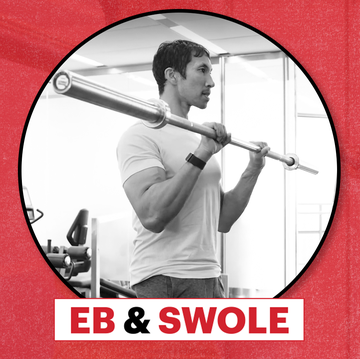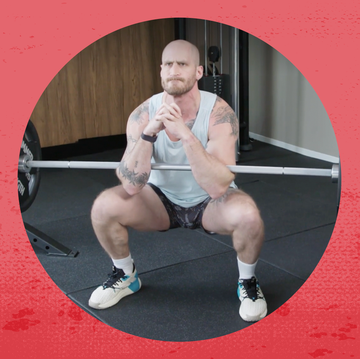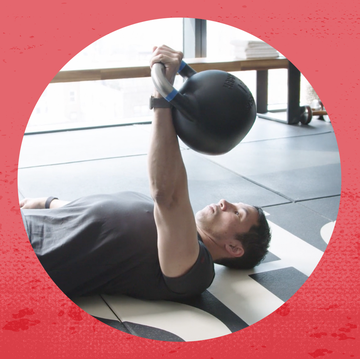When you first start training, anything and everything you do in the gym works.
In fact, studies show that beginners are able to both build muscle and lose body fat, all while being on very low calorie diets! This is damn near impossible for a drug-free vet.
Beginners can really do no wrong in the gym, as long as exercise form and technique are on point. But after you build some substantial muscle mass and strength, gains become harder and harder to come by.
You really need to dial in the right combination of intensity, volume, frequency, and variation to keep riding the gain train. And you also need to keep adjusting these variables to avoid plateaus.
Related: How Often Should You Lift to Build Muscle?
Something else also starts to happen after a couple months or years of training: You start discovering that your body doesn’t develop as symmetrically as you’d like. You have some muscle groups that grow like weeds and then others that won’t seem to respond no matter what you do to them.
Why is it that muscle doesn’t grow equally across our bodies? It has a lot to do with your unique combination of genetics and anatomy, and even what you do for a living (a mechanic will have way better forearm development than a desk jockey).
Related: How to Build Bigger Calves
In the beginning, the right approach is to work all of your muscle groups equally in terms of total work or volume (the number of work sets you do times the number of reps you do in each set).
As time passes, you start to see that a more imbalanced approach may be necessary. That is, you may need to focus on those slow-responding muscle groups for a short period of time to bring symmetry back to your physique and overall performance.
Your body has limited resources and can only handle so much training stress. So we’re going to stress the body part that needs the most TLC and put the others on autopilot.
That isn’t to say that you forget about your other muscle groups. But you will move to more of a maintenance mode where you do just enough work to stimulate those muscles so that they stick around—nothing more. In fact, studies show that it is much easier to maintain muscle than to build it.
This is the first in a series of specialization workouts that I’ve created to help you bring up a lagging body part as fast as possible.
This fierce and focused six-week program fuses the holy trinity of hypertrophy (muscle gain)—mechanical tension, muscle damage, and metabolic stress—to force your body to make a change.
Related: How to Gain Muscle
You’ll use the right mix of rep ranges, exercises, and tempos to max out your genetic potential for growth.
Since every guy seems to obsessed with the chest, that’s where we’re starting.
How it works:
Perform this routine 2 to 3 times per week exactly as outlined below. You can also see me demonstrate every movement in the video above.
Hit your other muscle groups 1 or 2 times per week with just 2 to 3 sets of 6 to 12 reps of a single exercise, stopping 1 to 2 reps short of failure on each set during this time frame.
Conventional training wisdom has you start with compound movements first and save the isolation moves for later. But our goal here is not performance: It’s to build as much muscle as possible in a short period of time.
Therefore, we will be starting with a strategic single-joint movement to enhance the mind-muscle connection and pre-fatigue the targeted body part. This will allow you to “feel” the muscle working more throughout your training session.
The Chest Specialization Workout
Mobility Warmup: Do a band or TRX chest stretch for 2 to 5 minutes.
Related: 3 Warmup Exercises You Should Do Before Every Workout
1. Dumbbell Eccentric Incline Fly
This move is designed to overload the eccentric/lowering portion of the exercise to spur muscle damage and subsequent growth. It will also develop the upper portion of your pectorals, which tend to be underdeveloped in most men.
Lower for a full 5 seconds from a fly position with the amount of elbow bend needed for you to feel your chest working the most. Hold for a count and then bring the weights tight to your sides and press the weight back up.
Do 3 to 5 sets of 5 reps. Rest 1 to 2 minutes between sets.
Weeks 1 and 2: 3 sets
Weeks 3 and 4: 4 sets
Weeks 5 and 6: 5 sets
2. Dumbbell Incline Press
This move will further develop the upper portion of your pectorals.
Using dumbbells also allows for a more full range of motion when compared to using a barbell. Plus, it helps fix any strength imbalances between your left and right sides because it works each arm independently with the same load.
Lower for a full 3 seconds, pause for a second at the bottom, and the press the weight up fast.
Related: How to Use Tempo Training to Build Bigger Muscles
Do 3 to 5 sets of 8 to 12 reps. Rest 1 to 2 minutes between sets.
Weeks 1 and 2: 3 sets
Weeks 3 and 4: 4 sets
Weeks 5 and 6: 5 sets
3. 1.5-Rep Barbell Bench Press and Plyo Pushup Superset
With 1.5-rep training, you do twice as many reps in the bottom position of the press, where you are weakest.
Lower all the way down, come up half way, go back down again, and then come all the way up. That’s 1 rep.
You will also immediately follow the 1.5-rep move with a plyometric movement to fire up your larger fast-twitch muscle fibers and build explosive pushing power.
Related: This 30-Minute Plyometric Workout Burns Fat and Increases Muscular Power
Do 6 to 8 reps of the 1.5-rep bench press, immediately followed by 10 plyo pushups (elevate your hands if you need to). Then rest 1 to 2 minutes.
That’s 1 superset. Repeat the superset for the corresponding number of sets.
Weeks 1 and 2: 3 sets
Weeks 3 and 4: 4 sets
Weeks 5 and 6: 5 sets
4. Dip and Extended ROM Pushup Mechanical Drop Set
A mechanical drop set is where you first perform a move you’re weaker at and then immediately follow it with a move you’re stronger at in a state of pre-fatigue. This leads to an extended time-under-tension and enhanced metabolic stress, which is key to muscle growth.
In addition, you’ll use an extended range of motion (ROM) on the pushups to make your chest muscles stretch more and work harder.
Do as many quality reps of dips as you can (use an assisted dip machine if needed). Then immediately perform as many extended ROM pushups as you can (elevate your hands if needed) with your hands placed on a pair of weight plate or blocks. Then rest 1 to 2 minutes.
Related: How to Do a Perfect Pushup
That’s 1 drop set. Repeat the drop set for the corresponding number of sets.
Weeks 1 and 2: 1 set
Weeks 3 and 4: 2 sets
Weeks 5 and 6: 3 sets
5. 3-Way Cable Crossover Fly
This high-rep protocol is designed to make your pecs pop like corn by getting a massive muscle pump. Don’t worry about the load here—just flood those muscles with as much blood as possible.
Perform 33 total reps in each of the following three positions to target your upper, mid, and lower pectorals, respectively, with no more than 20 seconds of rest between moves: high, medium, and low.
Rest 1 to 2 minutes after each round of 99 reps.
Perform this 99-rep protocol the corresponding number of times each week.
Weeks 1 and 2: 1 round
Weeks 3 and 4: 2 rounds
Weeks 5 and 6: 3 rounds
6. Bear Crawl
This is simple: Bear crawl for 10 minutes straight, resting as needed.
I love this as a chest day finisher because it carves up your serratus anterior (the shark gill-looking muscles alongside your ribcage), a key muscle involved in pressing that also stabilizes the shoulder joint. Crawls also work your whole body and burn fat everywhere.
If you’re overwhelmed by this challenge, you can start with 5 minutes in week 1 and then add a minute per week until you’re doing the full 10 minutes.












